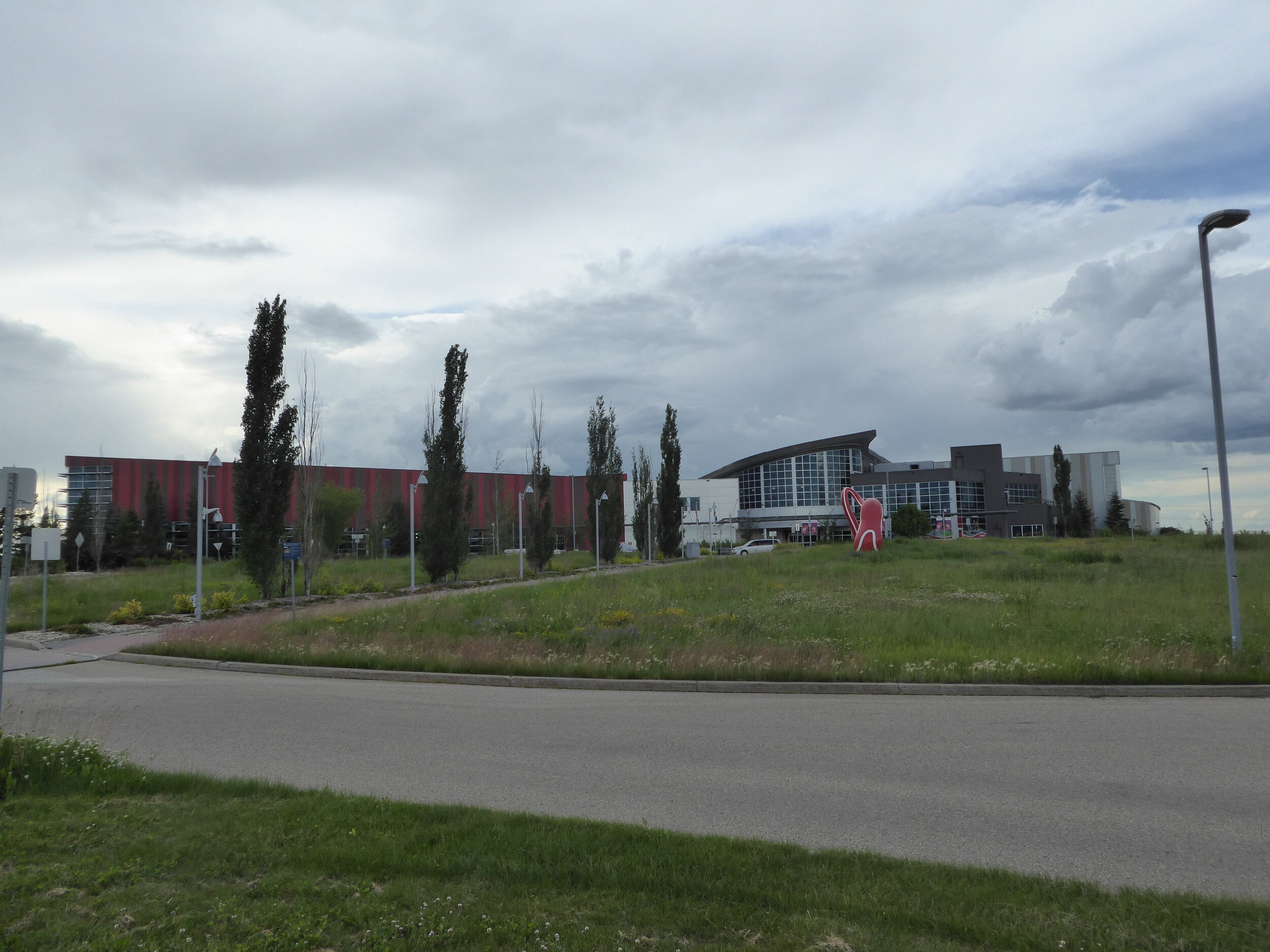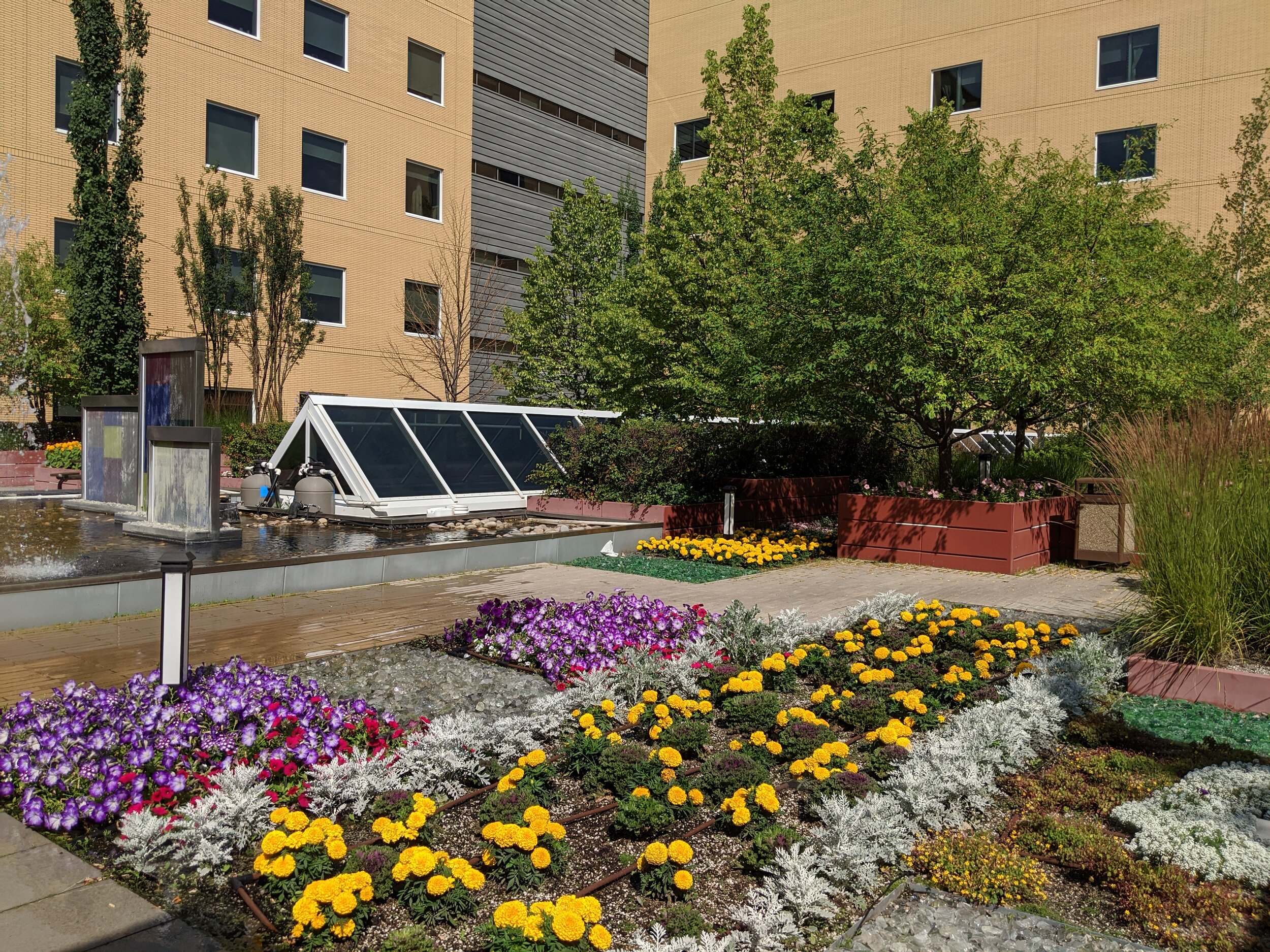
Part B. Climate Change and Extreme Heat
I. Extreme Heat and its Effects
Sun and Ice Cube
Heat from the glaring sun slowly melts a small ice cube.
The main effect of climate change is that it is warming the Earth and the atmosphere. This does not mean that Edmonton will no longer have cold or snowy days, but it does mean that we expect to have more warm weather than we did 100 years ago.
The problem with this is that it means that we will have more hot and very hot days in Edmonton. These hot days will do a lot more than melt ice cubes. As heat waves become more common, more people will experience heat-related illnesses like heat stroke.
Urban Heat Island
A sunset casts the Edmonton skyline in a warm glow.
Urban areas like the Edmonton city center are usually quite a bit warmer than the forests and grasslands that surround them. There are many reasons for this, but chief among them is that skyscrapers and roads like the ones in this picture trap the heat coming from the sun. This causes the city to warm up. Because of this difference in heat between urban and rural areas, cities are often called “Urban Heat Islands”.
Climate change will cause these “Heat Islands” to become even warmer. This means that cities like Edmonton will see an even greater increase in heat waves and hot days.
Attribution: “Strathcona Science Skyline Sunset” by Dave Sutherland is licensed under CC BY-NC-SA 2.0.
Health Effects of Extreme Heat
A young man wipes the sweat from his brow as the sun glares down on him on a hot day.
This man could be experiencing the health effects of extreme heat. Heat exhaustion, heat cramps, and heat rash are just some examples of the heat illnesses that hot days and heat waves can cause. These illnesses can cause dizziness, nausea, headaches, thirst, muscle cramps, skin rashes, and other effects. Sometimes, if you are in the heat for a long time, extreme heat can even lead to heat stroke, which can cause death if it is not properly treated.
Older adults, children, and people with chronic lung or heart conditions are most likely to get heat illnesses during heat waves. This means that these people should be especially careful about staying cool and healthy.
II. Individual Adaptation to Extreme Heat
Mitigation vs Adaptation
A photo of a group of solar panels in Edmonton (left) next to a photo of air conditioning units on a roof (right).
This picture shows the two types of things we can do to deal with climate change and its effects.
The solar panels are an example of what is called “Mitigation”. When we mitigate climate change, we try to slow or stop the warming of the Earth. We can do this by driving our cars less to burn less gas, or by getting electricity from sources that don’t release greenhouse gases, like solar panels. Mitigation is dealing with the problem at its root.
The air conditioning units in the picture are an example of the other strategy, “Adaptation”. We can adapt to climate change by preparing for the effects we know it will have, so that they will harm us less. An example of adaptation is putting an air conditioner in your home, so that you can stay cool during the heat waves that climate change will bring.
Both mitigation and adaptation are incredibly important, and both need to be used together to properly deal with climate change. However, this gallery will focus mostly on adaptation, on things we can do to live with the effects that climate change is already having. Below, you will find examples of things you and your community can do to adapt to the increase in heat climate change will bring. In the other sections of this gallery, you will also find examples of how to adapt to the other effects of climate change and air pollution.
Attribution:
This work, “Mitigation vs Adaptation”, is a derivative of “2008-07-11 Air Conditioners at UNC-CH” by Ildar Sagdejev, licensed under CC BY-SA 2.0, and “Solar Array in Edmonton, Alberta” by Green Energy Futures, used under CC BY-NC-SA 2.0. “Mitigation vs Adaptation” is licensed under CC BY-SA 2.0 by Markus Gaenzle.
Shade
A shaded picnic table overlooks a lake at Gold Bar Park. A drawstring bag sits on the right side of the table.
Taking a break under a tree or in another shaded area is a great way to cool off on a hot day. It can also help to prevent sunburn and skin tanning. As climate change increases the number of very hot days we get in Edmonton, staying in the shade will continue to be a good way to help us stay cool and adapt.
Air Conditioning
An air conditioning system on the roof of an Edmonton building.
Air conditioning, both in your own home and in public buildings can be a useful way to keep yourself cool. Be careful with your own air conditioning though. Air conditioners use lots of power, and that power often comes from sources that contribute to climate change. This means that air conditioners can actually add to climate change too.
In order to avoid this, you can try and keep yourself cool in other ways, such as seeking shade or drinking lots of water. If you do decide to use your air conditioner, try to keep it at the highest temperature you feel comfortable in to conserve energy. Anywhere between 22°C and 26°C (72°F to 79°F) is usually enough.
Attribution: “Hot and Cold” by Jerry Bowley is licensed under CC BY-SA 2.0.
Public Buildings
The Terwillegar Recreation Centre under a clouded sky.
Buildings like city rec centres, public libraries, and malls are another useful way to adapt to climate change, because they can help you stay cool during a heat wave. These buildings are usually air conditioned, and some, like the Terwillegar Recreation Centre, even have a swimming pool. If you ever find yourself outside on a hot day for long periods of time, and there is no shade around, spending a few hours in one of these buildings can help keep you from overheating. It can also help you avoid air pollution, which is often worse when it is very hot.
What to Wear and Bring Outside
A collection of items that can be useful in staying cool and healthy during extreme heat. One of the best ways to prepare for heat is to make sure you wear the right clothing for the weather.
Light and loose clothing can help keep you cool during hot weather, and a wide-brimmed hat like the one on the left of the image can help shade your face and neck, which will both keep you cool and prevent sunburn. If you don’t have a hat with a wide brim, then an umbrella (pictured, left) can also be used to provide shade.
Although it won't help with heat, sunscreen (pictured, center) can help protect your skin from sunburn, so long as it has an SPF higher than 15, and is used properly. Sunglasses can help shield your eyes from the sun, as long as they block both UV-A and UV-B rays.
Most importantly, make sure to drink plenty of water (pictured right) when it’s hot outside, even when you aren’t feeling thirsty.
For more information on ways to keep cool during a heat wave, visit https://www.canada.ca/en/health-canada/services/sun-safety/extreme-heat-heat-waves.html
Going Out at a Cooler Time of Day
Terwillegar Park slowly cools down as the sun sets and night approaches.
In Edmonton, the evening and morning tend to be much cooler than the early afternoon. This means that waiting to go outside until later in the day, or going out before noon, can help you make sure you don’t get too hot while you’re outside. However, if you’re going out later in the day, be careful of mosquitoes, as the evening is also when they are like to come out.
III. Community Adaptation to Extreme Heat
Parks and Green Space
Hawrelak Park on a sunny day. Downtown is visible in the distance.
Buildings like the ones in the background of this photo are one of the main reasons for the “Urban Heat Island” effect. Cities tend to be quite a bit hotter than the areas around them.
Trees, parks and other green space can help to reduce this effect. This means that parks like Hawrelak can actually help cool Edmonton down on hot days. Green space can also do many other things for a city. Plants can reduce pollution from the air and can mitigate climate change. Parks, fields and gardens also provide a great space for walks, picnics and other fun activities.
This means that planting trees and setting aside space for nature is a good way for a community to adapt to climate change.
Attribution: “Hawrelak Park” by Kurt Bauschardt is licensed under CC BY-SA 2.0.
Green Roofs and Rooftop Gardens
The Ted and Lois Hole Healing Garden on the roof of the Royal Alexandra Hospital. The Ted and Lois Hole Healing Garden is an example of a roof garden or “green roof”.
A green roof is simply any roof with grasses or other plants on it. Any building can have a green roof on it, from small houses to the tallest skyscrapers. Green roofs can also come in many shapes and sizes, from small gardens like the one in the picture, all the way up to full lawns that cover the entire top of the building.
Like any other green space, green roofs have many benefits. They help keep the building and the people inside it cool, they absorb water to prevent flooding, and they can provide a great place to relax.
For more information on green roofs, see the Edmonton green roofs fact sheet at https://www.edmonton.ca/city_government/documents/LID_Green_Roofs_Factsheet.pdf
Hospitals and Healthcare
The University of Alberta Hospital is cast in a warm glow by the evening sun.
Hospitals (like the one in the picture) and other healthcare facilities like clinics and doctor’s offices are very important to all kinds of health. They can also help with the health effects of climate change and air pollution.
Healthcare facilities can help to inform people about illnesses that have to do with climate change and air pollution. They also care for people who may come down with those illnesses. Finally, places like hospitals can help people keep their chronic diseases, like heart and lung conditions, under control. These conditions put people at greater risk of climate and air pollution health effects, so by treating these conditions, healthcare facilities help reduce the risk of these effects.
This means that one great way a community can adapt to climate change is to make sure that all of its members have access to good health care when they need it.
Attribution: “University of Alberta Hospital Complex Edmonton Alberta Canada O3A” by Winterforcemedia is in the public domain.
Sources:
EPA. (2019, June 11). Using Green Roofs to Reduce Heat Islands. Retrieved July/August, 2020, from https://www.epa.gov/heatislands/using-green-roofs-reduce-heat-islands
Health Canada. (2020, April 29). Reducing urban heat islands to protect health in Canada. Retrieved from https://www.canada.ca/en/services/health/publications/healthy-living/reducing-urban-heat-islands-protect-health-canada.html
Health Canada. (2020, July 14). Extreme heat: Heat waves. Retrieved July/August, 2020, from https://www.canada.ca/en/health-canada/services/sun-safety/extreme-heat-heat-waves.html
NASA. (2020, February 06). Climate Change Adaptation and Mitigation. Retrieved July/August, 2020, from https://climate.nasa.gov/solutions/adaptation-mitigation/
Warren, F.J. and Lemmen, D.S., editors (2014): Canada in a Changing Climate: Sector Perspectives on Impacts and Adaptation; Government of Canada, Ottawa, ON, 286p.
Ziegler, C., Morelli, V., & Fawibe, O. (2019). Climate Change and Underserved Communities. Physician Assistant Clinics, 4(1), 203-216. doi:10.1016/j.cpha.2018.08.008












